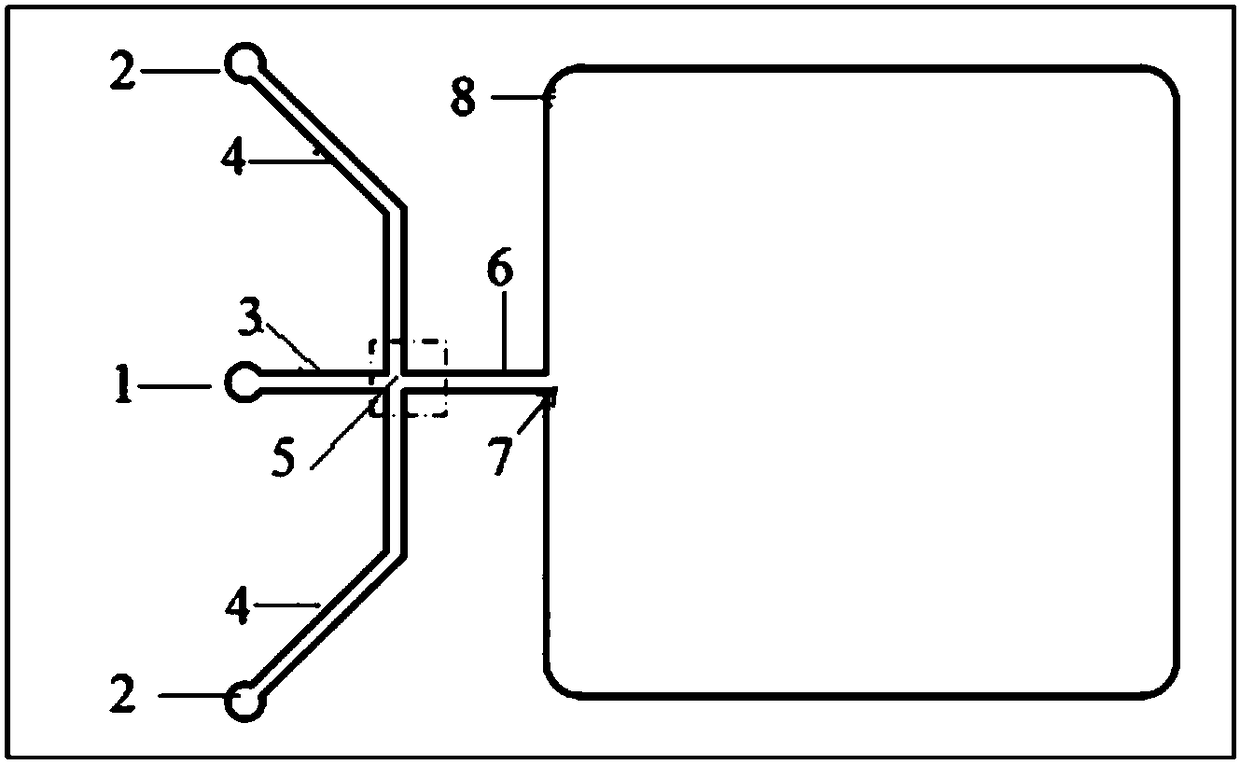Liquid-drop microfluidic chip for separation of single cells and preparation method for liquid-drop microfluidic chip
A single-cell separation and microfluidic chip technology, applied in the field of droplet microfluidic chips and their preparation, can solve the problems of cell damage, low capture efficiency, cumbersome and complicated operation steps, etc. Wide range of effects
- Summary
- Abstract
- Description
- Claims
- Application Information
AI Technical Summary
Problems solved by technology
Method used
Image
Examples
Embodiment 1
[0046] Preparation of superstructure SU-8 template for droplet microfluidic chip for single cell separation
[0047] The microfluidic chip uses photolithography and etching methods to prepare the SU-8 template with the protruding part of the channel; first, a layer of SU-8 glue with a thickness of 100 μm is thrown on the silicon wafer, and it is baked at 95 °C for 20 minutes, and then cooled naturally. The film was placed on the SU-8 glue plate, exposed to UV light for 30s, baked at 95°C for 20min, and cooled naturally; the SU-8 glue was developed with ethyl lactate for 10min, hardened at 180°C for 2h, and cooled naturally for use.
Embodiment 2
[0049] Preparation of a substructure SU-8 template for a droplet microfluidic chip for single-cell separation
[0050] First, throw a layer of SU-8 glue on the silicon wafer with a thickness of 150μm, bake at 95°C for 30min, cool down naturally, place the mask on the SU-8 glue plate, expose to UV for 45s, bake at 95°C for 30min, naturally Cool down; use ethyl lactate to develop the above-mentioned SU-8 glue for 10 minutes, harden the film at 180°C for 2 hours, and cool down naturally for use.
Embodiment 3
[0052] Preparation of PDMS chips for single cell isolation
[0053] The PDMS and the initiator were mixed uniformly at a volume ratio of 10:1, poured into the two SU-8 templates prepared in the previous stage, cured in an oven at 80 °C for 30 min, and the PDMS and SU-8 templates were peeled off to obtain the upper and lower layers with structures. Chip; cut the upper PDMS chip into transparent square pits along the edge of the liquid storage tank, and use a puncher to punch holes at the inlet of the dispersed phase and the inlet of the continuous phase; the upper and lower layers of the chip are treated with plasma for 120s, and the key Co-sealing spare.
[0054] The aqueous single cell suspension of the chip flows through the dispersed phase inlet channel 3 from the dispersed phase inlet 1, the oil phase liquid flows through the continuous phase inlet channel 4 from the continuous phase inlet 2, and the two-phase liquid intersects the cross channel 5. Convergence, when the flu...
PUM
 Login to View More
Login to View More Abstract
Description
Claims
Application Information
 Login to View More
Login to View More - R&D
- Intellectual Property
- Life Sciences
- Materials
- Tech Scout
- Unparalleled Data Quality
- Higher Quality Content
- 60% Fewer Hallucinations
Browse by: Latest US Patents, China's latest patents, Technical Efficacy Thesaurus, Application Domain, Technology Topic, Popular Technical Reports.
© 2025 PatSnap. All rights reserved.Legal|Privacy policy|Modern Slavery Act Transparency Statement|Sitemap|About US| Contact US: help@patsnap.com



